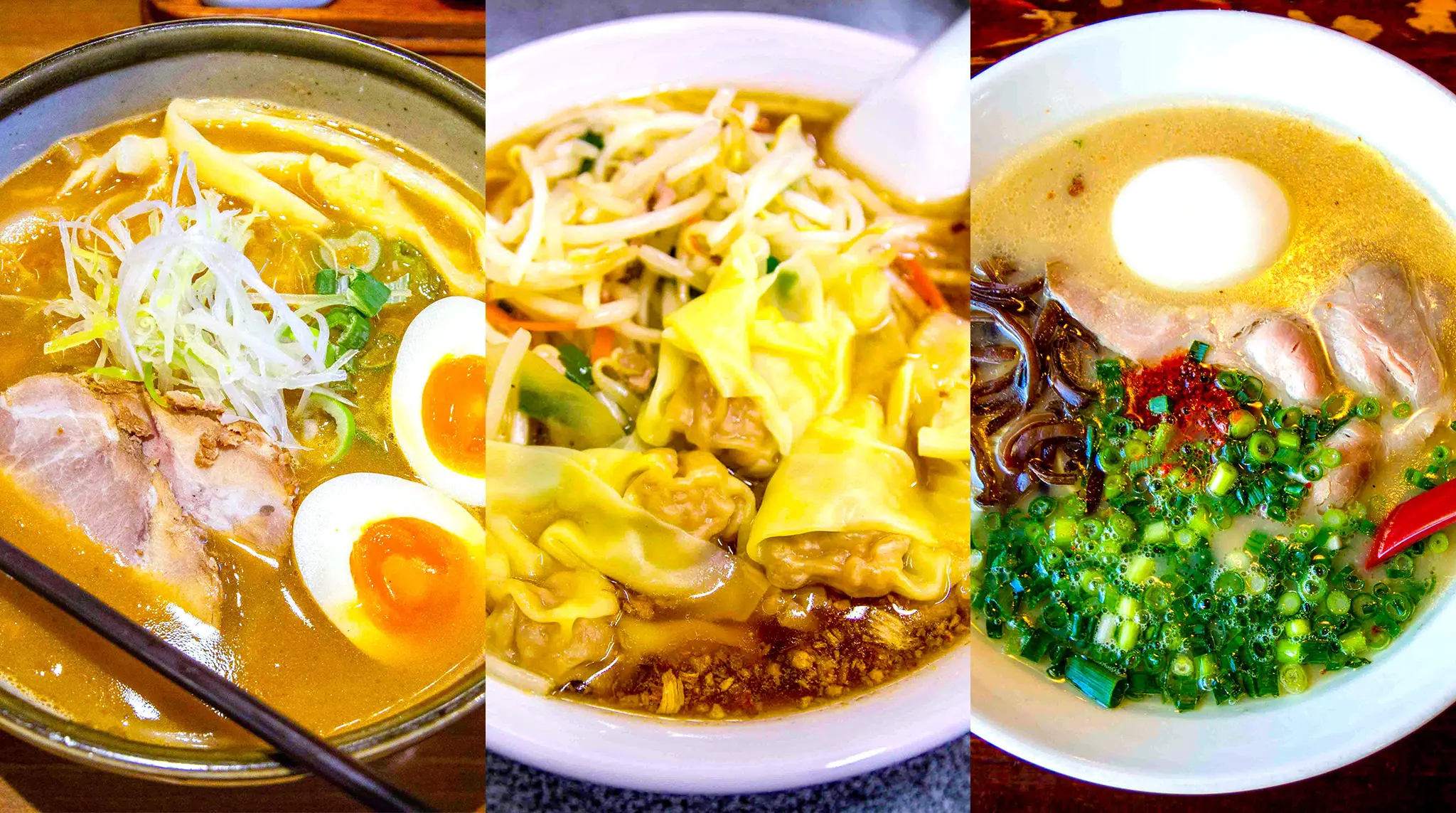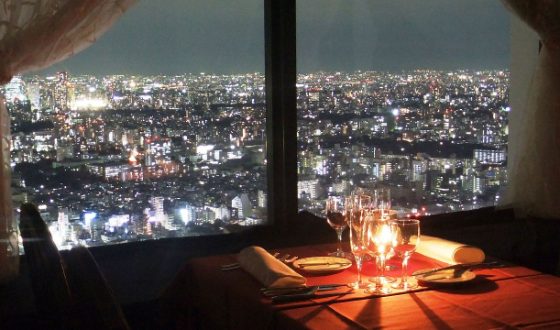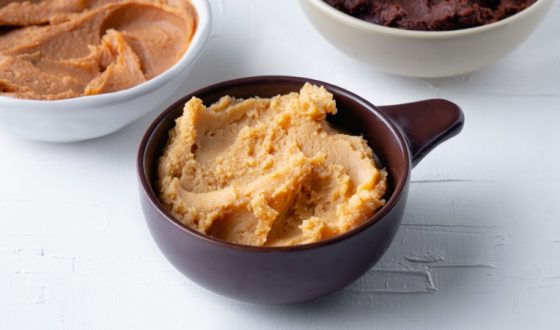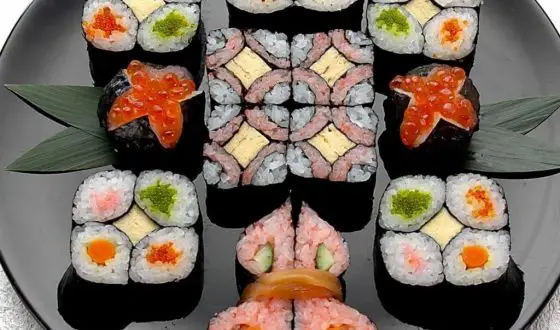Best Ramen In Shinjuku: Must Try When Visiting Tokyo
Due to its combination of modern and traditional Japanese culture, Shinjuku is frequently referred to as the heart of Tokyo. In addition, it is also one of Tokyo’s food attractions, with ramen being its most popular and greatest dish.
Below, these 12 eateries are for you if you’re seeking the best ramen in Shinjuku (not in any particular order). Each of these restaurants have their own unique recipes but they all serve up the greatest ramen in common.
12 Best Ramen Shops In Shinjuku You Should Try
1. Ichiran
The most well-known and well-liked ramen shop in Japan is Ichiran Ramen, which serves the traditional Tonkotsu ramen (a thick, creamy soup prepared with pork broth). There are already more than 70 Ichiran branches both domestically and overseas.
Ichiran mainly serves one style of Tonkotsu ramen, which is a rich broth with a creamy texture, served with sliced pork, green onions, and a chili red sauce for a great combination of flavor.
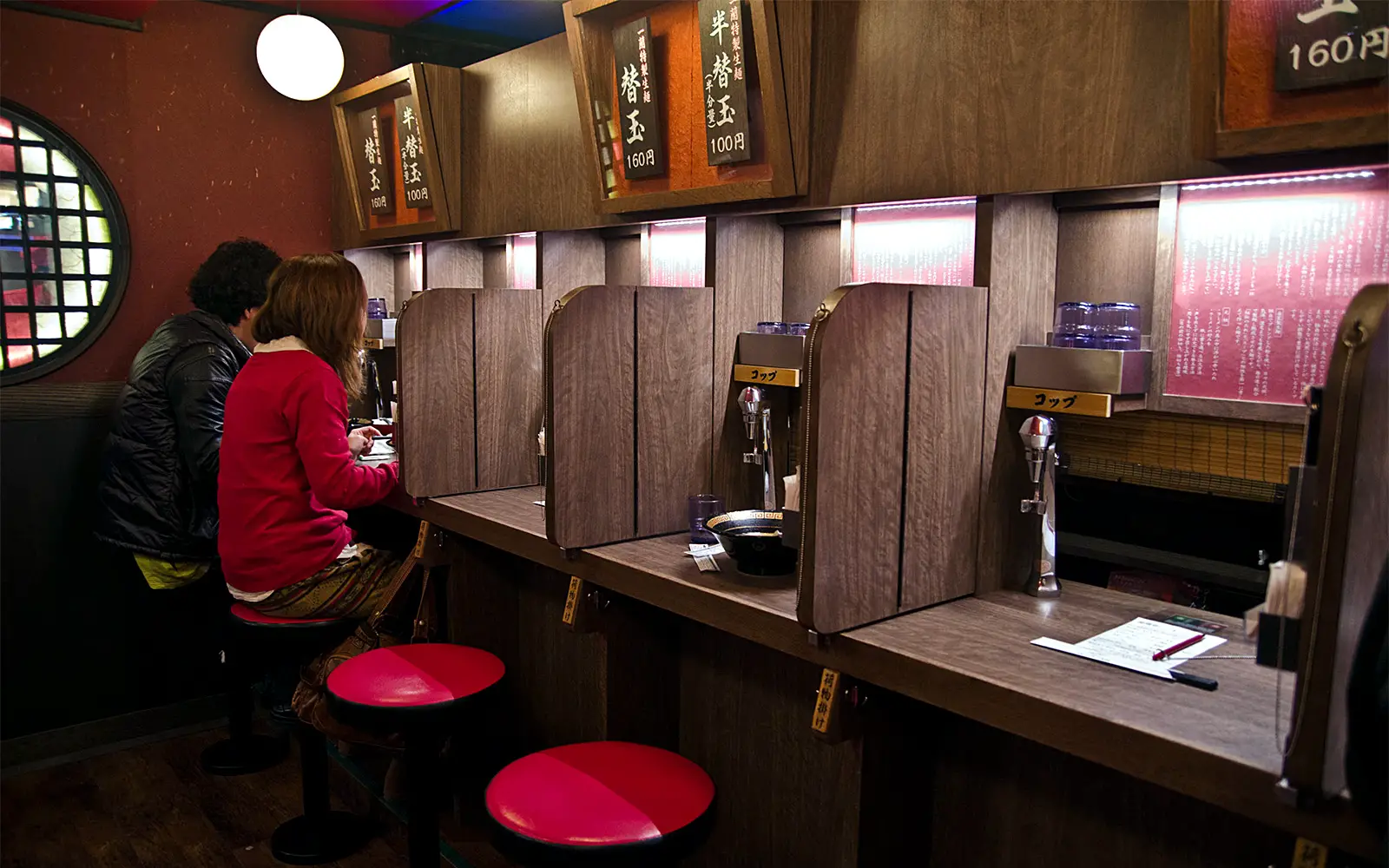
The most well-known and well-liked ramen shop in Japan is Ichiran Ramen, which serves the traditional Tonkotsu ramen (a thick, creamy soup prepared with pork broth). (Source: Internet)
Ichiran’s order feature enables customers to customize their own ramen bowl by selecting 7 preferences, including the spiciness, richness, and firmness of the noodles and soup. Also, Ichiran provides a unique sitting arrangement with booths that are partitioned off for each visitor so they may enjoy their ramen meals undisturbed.
- Location: 34-11 Peace Bldg B1F, Shinjuku 3 Chome, Shinjuku 160-0022 Tokyo (3 minutes on foot from the east exit of JR Shinjuku station)
- Price: from 890 Yen to 1500 Yen (~$6.6 to ~$11.3)
- Time: 12:00 AM – 11:59 PM (open 24 hours)
- Phone number: +81 3-3225-5518
2. Fuujin
A Tsukemen style ramen shop called Fuunji is located in Tokyo’s Shinjuku district. It ranks among the most famous Ramen restaurants in Tokyo and attracts foodies and Ramen enthusiasts from every corner of Japan.
Tsukemen is a sort of ramen dish in which the noodles and soup are served separately. Trying Tsukemen style ramen, you will have the most unique Ramen experience while visiting Japan! Delicious Tsukemen dishes with thick noodles and a flavorful soup cooked with chicken and fish stocks are served at Fuunji. In addition to Tsukemen, traditional Ramen is also well-liked.
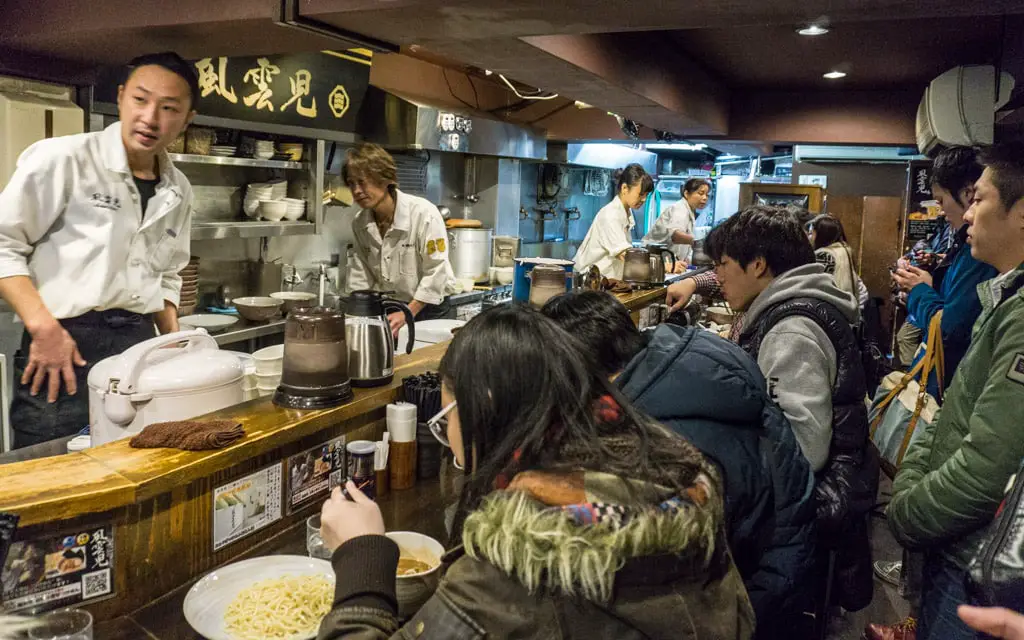
It ranks among the most famous Ramen restaurants in Tokyo and attracts foodies and Ramen enthusiasts from every corner of Japan. (Source: Internet)
Be willing to wait for at least 30 minutes in line, but it will be well worth it because Fuunji has kept its position as one of Tokyo’s busiest Ramen restaurants despite Shinjuku being one of the city’s most competitive Ramen areas.
- Location: 2-14-3 Hokuto Daiichi Building 1F, Yoyogi, Shibuya 151-0053 Tokyo (JR Shinjuku station south exit is a 5-minute walk away)
- Price: around 800 Yen to 1000 Yen (~$6 to ~$7.5)
- Time: 11:00 AM – 3:00 PM; 5:00 PM – 9:00 PM
- Phone number: +81 3-6413-8480
3. Menya Musashi Shinjuku Sohonten
One of Tokyo’s most wonderful ramen eateries is Menya Musashi. There are currently more than 10 chain branches in the Tokyo metropolitan regions, with the restaurant’s initial flagship store opening in Shinjuku in 1996. With its substantial and flavorful bowls of ramen, Menya Musashi has succeeded in standing out among the thousands of Ramen shops in Tokyo, and is today regarded as one of the most renowned Ramen shops in Japan.
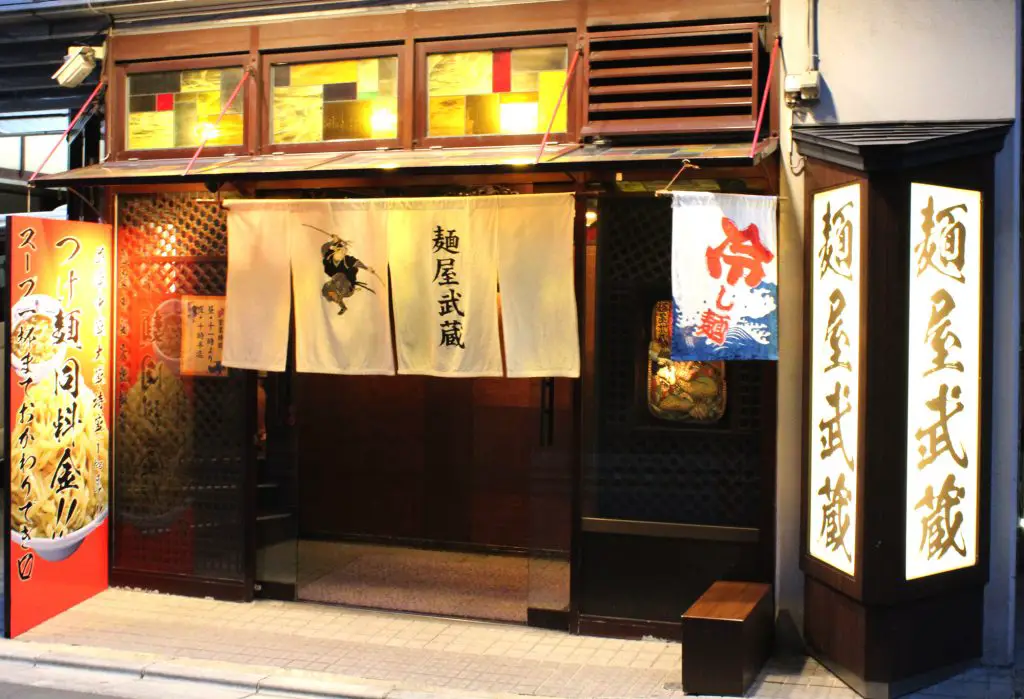
With its substantial and flavorful bowls of ramen, Menya Musashi has succeeded in standing out among the thousands of Ramen shops in Tokyo, and is today regarded as one of the most renowned Ramen shops in Japan. (Source: Internet)
The perfect combination of chicken, pork, and fish soup serves to create Menya Musashi’s ramen, offering it a rich, excellent flavor. Without major, plentiful toppings like pieces of pork belly as well as a half-boiled egg, the bowls of ramen cannot be done successfully. Tsukemen-style ramen bowls are also served.
As I previously stated, there are presently more than 10 Menya Musashi spots in downtown Tokyo, and each one serves an original menu. You can also check out a few more other Menya Musashi branches in Tokyo if you really love the flavor of the Shinjuku.
- Location: 7-2-6 K1 Bldg. 1F, Nishishinjuku, Shinjuku 160-0023 Tokyo (4 minutes on foot from the east exit of JR Shinjuku station)
- Price: around 1000 Yen (~$7.5)
- Time: 11:00 AM – 10:30 PM
- Phone number: +81 3-3363-4634
4. Ramen Hayashida
Pork is the most commonly used ingredient for ramen dish bases. Yet, Ramen Hayashida has distinguished itself in the very crowded and extremely competitive Shinjuku market by providing excellent chicken and duck ramen bowls, even a unique sea bass-based ramen recipe.
At this fantastic restaurant, everything is served to excellence. Keep in mind that it opened in 2017 and has already established a reputation in such a crowded area of the city. As Ramen Hayashida is open on all seven days, you don’t need to fret or think too hard if you suddenly develop a hankering for the greatest duck ramen in Tokyo.
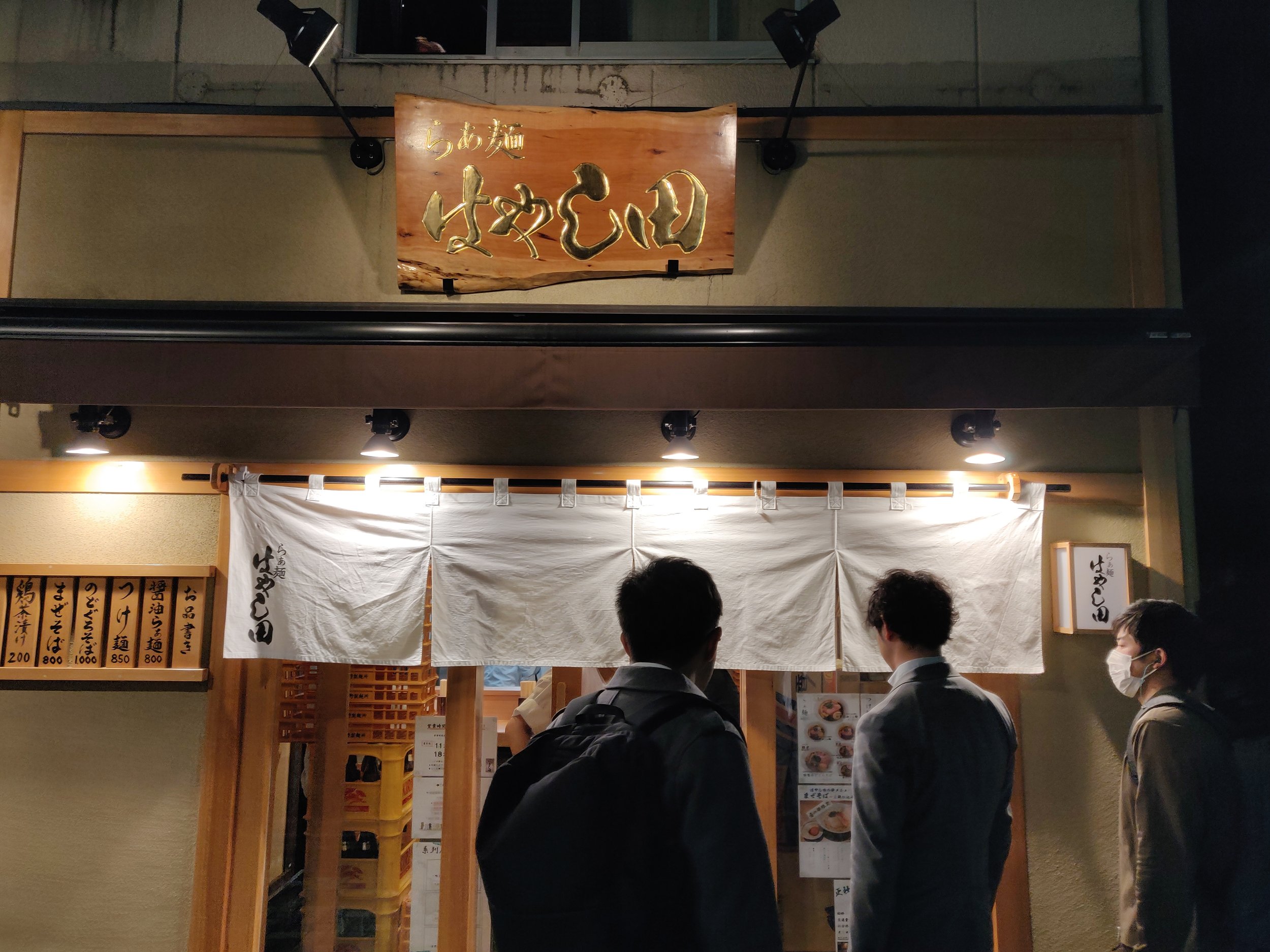
Yet, Ramen Hayashida has distinguished itself in the very crowded and extremely competitive Shinjuku market by providing excellent chicken and duck ramen bowls, even a unique sea bass-based ramen recipe. (Source: Internet)
Because of its uniqueness and consistently great quality, Ramen Hayashida has been able to stand out in Shinjuku, which is known as the ramen capital of the world. This shop has a special take on ramen, if you’re seeking it.
- Location: 31-5 Pegasus Hall 1F, Shinjuku 3 Chome, Shinjuku 160-0022 Tokyo
- Price: about 800 Yen to 1000 Yen (~$6 to ~$7.5)
- Time: 11:00 AM – 4:00 PM; 6:00 PM – 10:00 PM
- Phone number: +81 3-6380-0047
5. Menya Sho (Menya Syo)
Go no further than Menya Sho if you’re finding the greatest, most welcoming for foreigners ramen shop in Shinjuku. For those who cannot read Japanese, Menya Sho offers an English menu and good service. The staff is also quite nice, offering aprons and hair ties for your eating experience, and generally exuding a lovely, homey feel.
This Chicken Shio Ramen, a form of chintan-based soup in which the broth is created from a soft boil of chicken and vegetables, is the signature dish of the restaurant. They use a salt mixture from four various countries to make their flavoring sauce, or tare. The greatest Shio Ramen in Shinjuku, without a doubt.
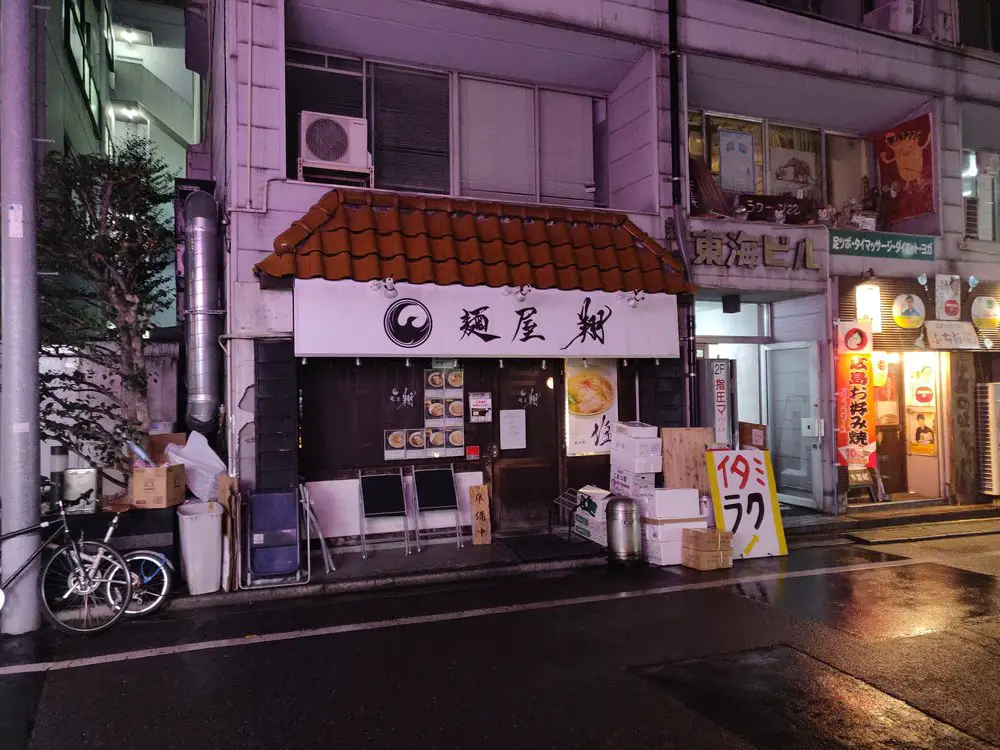
Go no further than Menya Sho if you’re finding the greatest, most welcoming for foreigners ramen shop in Shinjuku. (Source: Internet)
You may pick from a variety of rich braised and smoked char sui, and you can order more toppings including flavored eggs and nori. On Wednesdays, Menya Syo (also called as Menya Sho) serves its unique miso ramen, which is a must try item.
- Location: 7-22-34, Nishishinjuku, Shinjuku 160-0023 Tokyo
- Price: around 900 Yen to 1400 Yen (~$6.7 to ~$10.5)
- Time: 11:00 AM – 3:00 PM; 5:00 PM – 9:00 PM
- Phone number: +81 3-3364-5787
You can also like:
Food Prices In Japan – What Should My Daily Food Budget Be?
10+ Best Beer Bars in Tokyo Voted By Most of Customers in 2022
6. Niboshi Ramen Nagi Shinjuku Golden Gai
With a total of 8 locations in downtown Tokyo, Niboshi Ramen Nagi is a franchised ramen restaurant. Their famous Ramen is created using “Niboshi” (dried sardine) stock, which has a flavorful, rich scent. Try this ramen if you want a distinct flavor from the typical pork-broth ramen! The eatery is located within the popular drinking zone of Golden Gai.
This Nagi, which is on the second floor of an ancient wooden home, has a distinct neighborhood aroma that welcomes you as soon as you enter the door. And it’s understandable why; this restaurant is known for its spicy niboshi ramen, which is created by boiling a large number of dried sardines for hours to create a unique soup with a strong flavor.
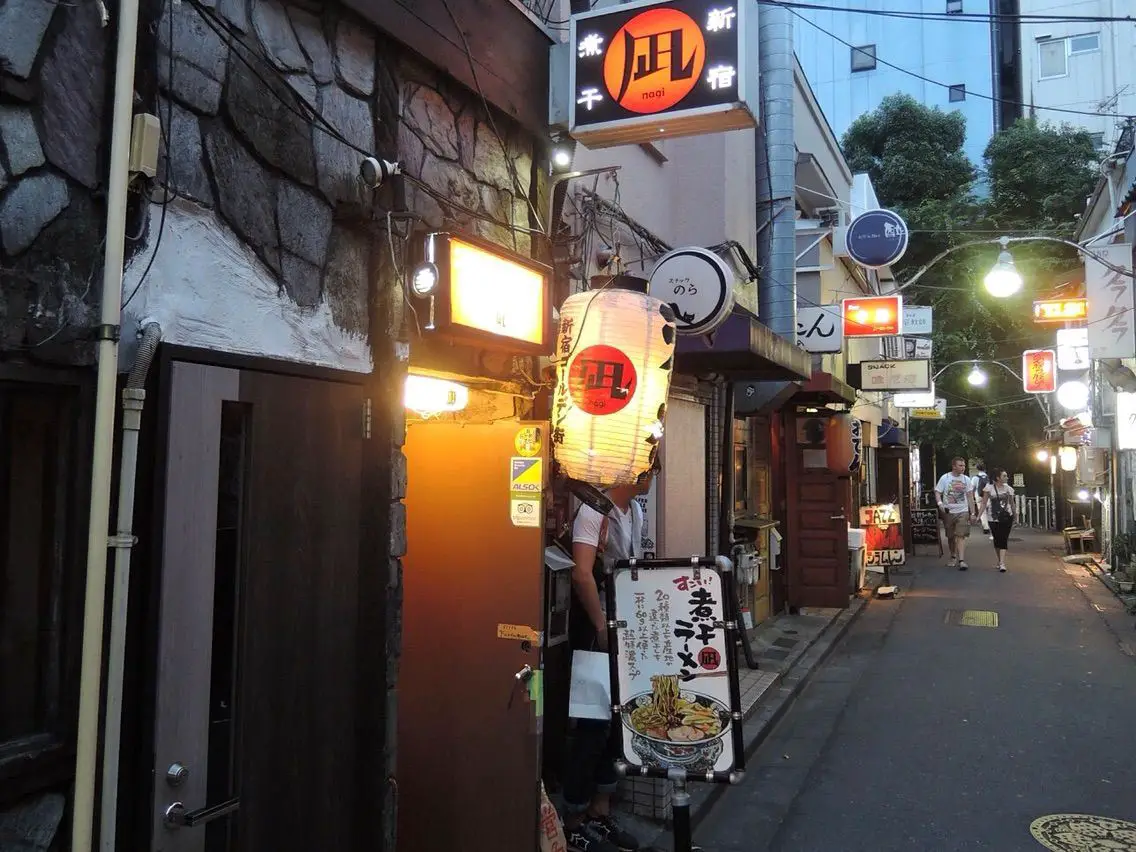
Their famous Ramen is created using “Niboshi” (dried sardine) stock, which has a flavorful, rich scent. (Source: Internet)
We suggest the Niboshi Ramen, which includes a variety of curly and flattened noodles along with scallions, slices of pork, menma (flavored bamboo shoots), nori (a type of seaweed), and a soft-boiled egg.
- Location: 1-1-10 2F, Kabukicho, Shinjuku 160-0021 Tokyo
- Price: around 800 to 1000 Yen (~$6 to ~$7.5)
- Time: 11:00 AM – 9:00 PM
- Phone number: +81 3-3205-1925
7. Ebisoba Ichigen
This is unquestionably advised if you’re seeking a different approach to the typical pork soup Ramen experience. A ramen restaurant called Ebisoba Ichigen was first established in Sapporo City, Hokkaido, and it presently has two locations in Tokyo. Ichigen offers special Ramen made with delicious shrimp broth that has a rich taste. This ramen with excellent shrimp flavor can blow your mind!
More flexible than other ramen shops, in Ebisoba Ichigen, you can pick the noodle size, the shio, soy, or miso base of the broth, and also the level of richness. When more pork seasoning is added to intensify the richness, the richer you choose to be, the more shrimp flavor will come through.
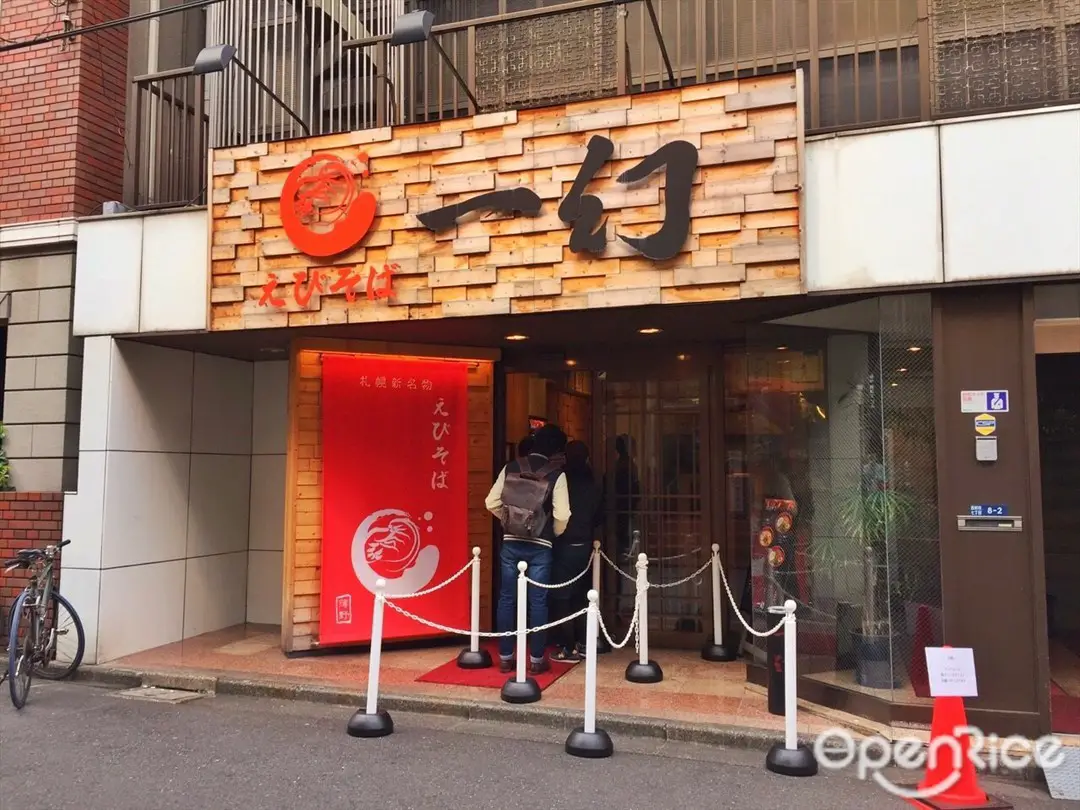
A ramen restaurant called Ebisoba Ichigen was first established in Sapporo City, Hokkaido, and it presently has two locations in Tokyo. (Source: Internet)
The finishing touches on your ramen are going to include delectable char sui, a savory egg, and spring onions. Also, you may order sides such the gyoza and onigiri rice balls and dipping sauce that are also available in the front section of the store’s vending machine. This popular ramen restaurant in Shinjuku will have you going back many times because of its minimal wooden, comfortable atmosphere and moreish customizable meals.
- Location: 7-8-2 1F Fukuhachi Bldg., Nishishinjuku, Shinjuku 160-0023 Tokyo
- Price: around 1000 Yen (~$7.5)
- Time: 11:00 AM – 11:00 PM
- Phone number: +81 3-5937-4155
8. Ramen Tatsunoya
The well-known ramen shop Ramen Tatsunoya is located in Kurume City, Fukuoka Prefecture. It has more than 10 branches throughout Japan, mostly in the Kyushu region, but there are also two in Tokyo. Tonkotsu Ramen (pork broth) was invented in Kurume City, which is also one of Japan’s Ramen cities. Tatsunoya is a must-try ramen for everyone who likes traditional Kyushu style tonkotsu ramen, such as Ichiran and Ippudo.
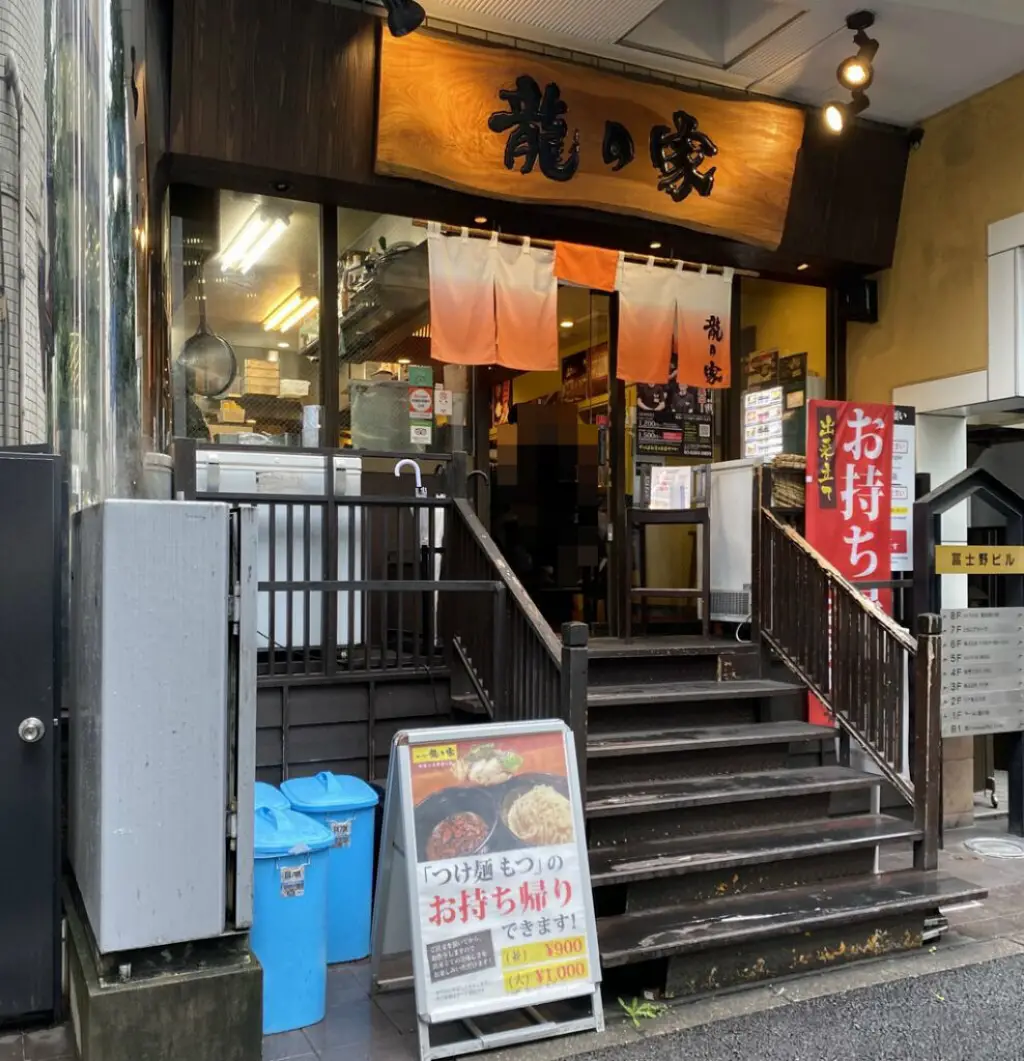
The well-known ramen shop Ramen Tatsunoya is located in Kurume City, Fukuoka Prefecture. (Source: Internet)
With two versions of Tonkotsu Ramen flavors rich – black bowl or lighter – red bowl, all offered with the classic thin flat noodle, creamy and aromatic Tonkotsu soup, and a few slices of succulent pork belly—Tatsunoya maintains the original taste of Kurume style Tonkotsu Ramen.
Shinjuku, one of the most aggressive Ramen areas in Japan, is where one Tatsunoya’s spot is located. Only in Tokyo branches, their Tsukemen ramen are served.
- Location: 7-4-5 Fujino Bldg, 1F, Nishishinjuku, Shinjuku 160-0023 Tokyo
- Price: around 800 Yen to 1000 Yen (~$6 to ~$7.5)
- Time: 11:00 AM – 11:30 PM
- Phone number: +81 3-6304-0899
9. Ippudo
Ippudo, among the top-rated ramen restaurants in Japan, was founded in Hakata City, Fukuoka Prefecture, in 1985. It serves original Hakata style ramen in a rich pork broth. After opening several branches in Asia, Europe, and the United States, Ippudo has gained a great amount of popularity across the world.
Ippudo has a menu that is almost reliable for guests, making it one of the most well-known chains in the Tokyo area. The classic soup, the modern soup (rich taste), and the spicy soup are often your three options.
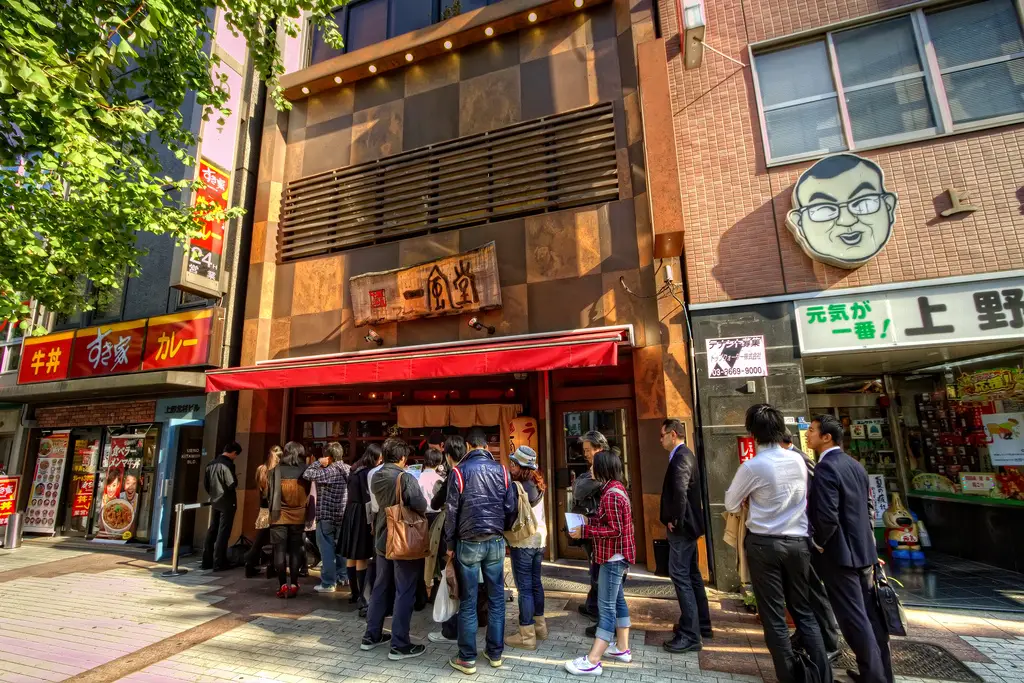
Ippudo, among the top-rated ramen restaurants in Japan, was founded in Hakata City, Fukuoka Prefecture, in 1985. (Source: Internet)
Ippudo is a tonkotsu ramen establishment, where “tonkotsu” refers to the use of pork bone in the broth. Since they are made in the Hakata style, the noodles have a solid center, furthermore includes a mouthwatering chunk of pork belly on top. Enjoy their signature “Tonkotsu Ramen” which has thin noodles, a rich and creamy pork broth soup, with a spicy red sauce.
- Location: 6-4-1 Nishi-Shinjuku B1 Shinjuku i-Land Tower Atrium, Nishishinjuku, Shinjuku 163-1390 Tokyo
- Price: Less than 1000 Yen (~$7.5)
- Time: 11:00 AM – 10:00 PM (Mon – Fri); 11:00 AM – 4:00 PM (Sat – Sun)
- Phone number: +81 3-5990-5288
10. Menya Kaijin
It does seem that Tonkotsu Ramen (a thick, creamy pork broth Ramen) is popular among most people, but what about trying something different? Menya Kaijin takes great pride in making exquisite Shio Ramen (salt-based light soup, with chicken or seafood is the main ingredient made of the broth). They simmer saw edged perch to make their salt-based soup.
It just takes a short walk from Shinjuku Station to Menya Kaijin. Very likely, you’ll observe a line building in front of the store. Because they are on the second floor, you can roughly estimate how long the queue is there.
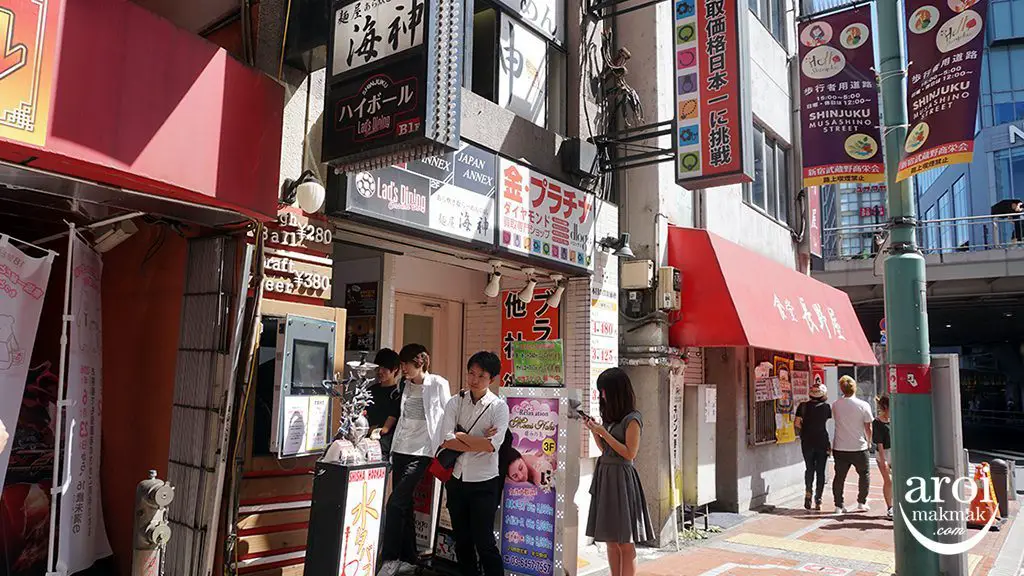
Menya Kaijin takes great pride in making exquisite Shio Ramen (salt-based light soup, with chicken or seafood is the main ingredient made of the broth). (Source: Internet)
The soup is smooth and light. They use two distinct types of wheat to make their smooth and thin noodles. Here, “Heshiko yaki onigiri” (rice balls) are a favorite as well. Either separately or mixed into the soup, you can eat it.
- Location: 35-7 Sanraku Bldg, 2F, Shinjuku-3 Chome, Shinjuku 160-0022 Tokyo
- Price: around 1000 Yen (~$7.5)
- Time: 11:00 AM – 3:00 PM; 4:30 PM – 11:30 PM (Mon – Fri)
- 11:00 AM – 11:00 PM (Sat – Sun)
- Phone number: +81 3-3356-5658
11. Ramen Yamaguchi
Like other meals, ramen has trends in popularity. And Ramen Yamaguchi has established itself as being especially well-liked in recent years due to its excellent chicken broth ramen, which is a popular style of ramen at the moment.
Considering that chicken may frequently be much dryer than pork, the eggs that are served with this unique bowl of chicken ramen bring so much taste and texture to the dish and the whole experience.
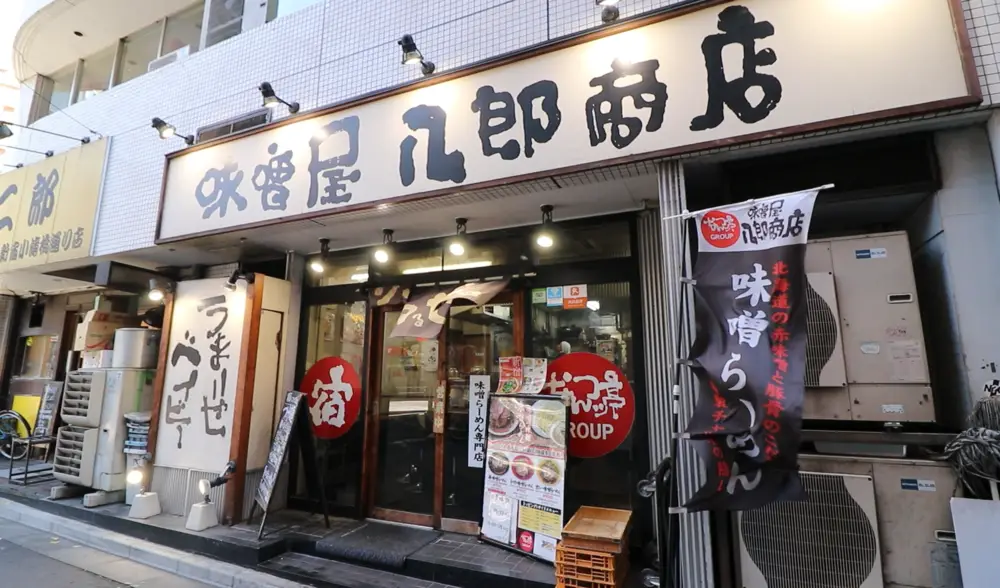
And Ramen Yamaguchi has established itself as being especially well-liked in recent years due to its excellent chicken broth ramen, which is a popular style of ramen at the moment. (Source: Internet)
Nonetheless, the chefs at Ramen Yamaguchi are expert with chicken and understand how to combine it with other foods (like the mentioned egg) to create a dish that is perfectly seasoned, succulent, and delicious.
- Location: 2-11-13 Nishi Waseda, Shinjuku 162-0051 Tokyo
- Price: around 1000 Yen to 2000 Yen (~$7.5 to ~$15)
- Time: 11:30 AM – 3:00 PM; 5:30 PM – 9:00 PM
- 11:30 AM – 9:00 PM (On Sunday)
- Phone number: +81 3-3204-5120
12. Soba House Konjiki Hototogisu
The fact that Hototogisu was named as a favorite restaurant in the 2018 version of the guide indicates how well-liked it was even before receiving one star. Ramen lovers from all over the world have flocked to enjoy a bowl of their renowned shellfish broth ramen in its position in the heart of Shinjuku.
After Tsuta Ramen and Nakiryu Ramen, Konjiki Hototogisu is the third ramen shop in the word to achieve a Michelin star. The unique Shouyu soba is created with three different soup stocks: pork broth, Japanese stock (wadashi) and hamaguri clam dashi and topped with truffle sauce, porcini oil, and flakes for a powerful umami flavor.
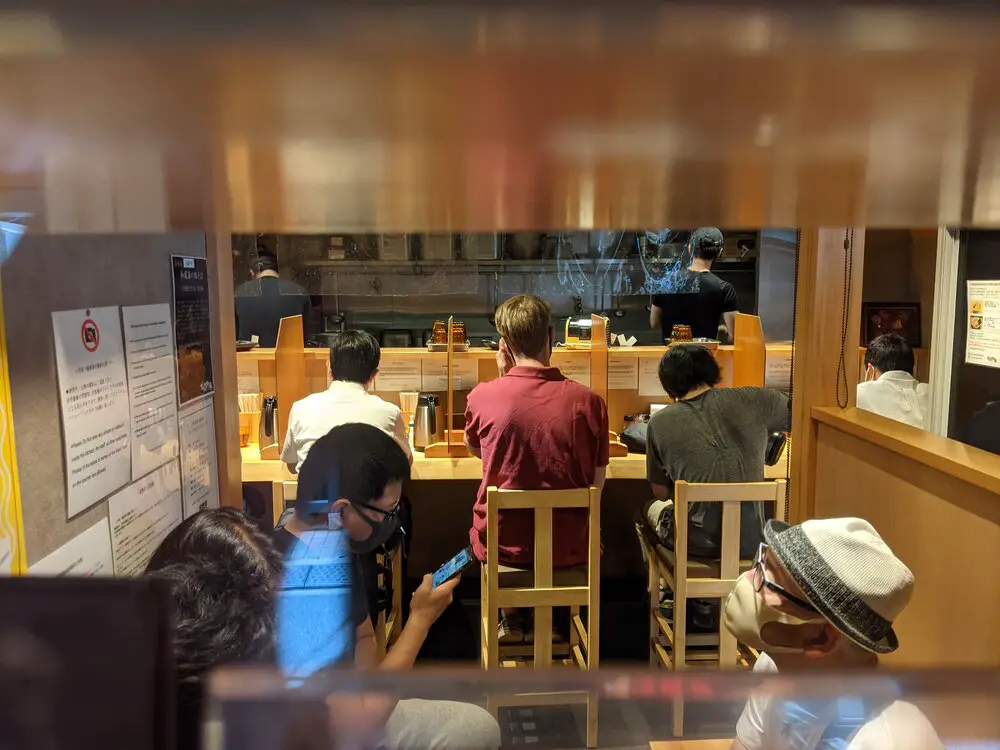
The fact that Hototogisu was named as a favorite restaurant in the 2018 version of the guide indicates how well-liked it was even before receiving one star. (Source: Internet)
To assist you with the ordering, there is an English explanatory sheet at the vending machine. Keep in mind that there are just seven counter seats and a few tiny tables for two people. Expect a line, but it will be worth it because a bowl of this Michelin-rated ramen only costs around 1000 Yen.
- Location: 2-4-1 Shinjuku No.22 Kyutei Mansion 1F, Shinjuku 160-0022 Tokyo
- Price: around 1000 Yen (~$7.5)
- Time: 11:30 AM – 3:00 PM; 6:30 PM – 9:30 PM (Mon – Sat)
- 11:30 AM – 3:00 PM (On Sunday)
- Phone number: +81 3-5315-4733
FAQs
1. In Japan, how much does a bowl of ramen cost?
In Japan, ramen is a casual meal that typically costs between 700 and 1,400 Yen a bowl (~$5.3 to ~$11). Even with additional toppings, a side dish, and a beverage like beer, the price will probably not exceed 2,000 Yen.
2. How many styles of ramen are there?
Japanese ramen may be classified into four primary types depending on the tare, or base taste: Shio (salt-based ramen), tonkotsu (pork broth ramen), shoyu (ramen seasoned with soy sauce) and miso (ramen flavored with soybean paste).
3. Which ramen shops have Michelin stars in Japan?
You’d assume that Japan, the home of ramen, would have a big list of ramen restaurants with Michelin stars. Unexpectedly, that is not the case. In reality, it wasn’t until the year 2016 that a ramen shop received the famous culinary guide’s first-ever star.
The honor of becoming the first ramen shop in the world to be awarded a prized Michelin star belongs to Tsuta in Tokyo (sadly they lost now). In 2017, Nakiryu accomplished the same, and in 2019, it’s Konjiki Hototogisu. And now, Ginza Hachigo, one of the most favorite ramen shops in Tokyo, has also received a star.
4. What is the most popular type of ramen in Japan?
Tonkotsu shoyu ramen, which is produced with a broth combination of tonkotsu pork bone broth and broth based on soy sauce, was voted the most popular flavor of ramen in Japan by Japanese people. It resembles a cross between tonkotsu ramen from the South and shoyu ramen from other regions of Japan. Tonkotsu shoyu ramen was even so delicious that it took on immediately, although not all hybrid items, like the Prius, are first approved by everyone.
A lighter brown colored intense and interestingly mellow broth is created by combining the thin and light shoyu soup with the rich, aromatic, almost creamy tonkotsu broth. The majority of Japanese people are in agreement that this broth tastes absolutely fantastic.
5. Are ramen noodles healthy to eat?
For various reasons, such as the quantity of white flour-based noodles it contains per dish, which makes it highly starchy and deleterious to the control of blood sugar, ramen is not often regarded as a “healthy meal” in Japanese restaurants. The broth, which is often a little salty, might also include some extra lipids.
Like with other noodle dishes, Japanese ramen is rich in fat, carbohydrates, and sodium. Due to its large calorie content, it significantly increases the risk of weight gain. But, you may eat one or two medium-sized bowls of each meal as long as you are conscious of the total calories you consume each day.
6. How to eat Japanese ramen?
Chopsticks, which are commonly available on the table, are used to eat ramen. Moreover, a Chinese style spoon is typically provided to aid in eating the soup and adding toppings. It’s perfectly fine to lift the bowl up and taste the soup directly from it.
Ramen noodles should really be eaten right away since they soon get mushy. When eating ramen, like with other noodle meals in Japan, you are able to slurp. Slurping helps cool down the scalding hot noodles when they reach your tongue and intensifies the taste. It’s allowed to leave part of the soup in the bowl after the meal. Although it is seen to be respectful to the chefs to do so, you are not required to drink the entirety of the bowl in order to be courteous.
7. Which Japanese city serves the greatest ramen?
Tokyo is a key location when exploring the history of ramen in Japan since it is said to have produced the original ramen styles. As a result, Tokyo is home to some of the most renowned ramen chefs as well as some of the country’s oldest ramen restaurants!
8. What taste does Japanese ramen have?
The broth is often made from the bones of chickens, pork, and beef, although occasionally it also includes seafood like shrimp. The noodles are frequently curled and on the thinner side, and the flavor is typically salty and light with a transparent broth.
9. What ramen dish is the most challenging?
Shio ramen, according to some chefs, is the most challenging to master since it can’t rely only on umami-rich ingredients like miso or soy sauce to provide complexity and flavor.
10. What makes ramen popular in Japan?
The food’s accessibility and affordability helped it become widespread throughout Japan more than a century ago. The relationship between ramen and Japan is unbreakable. The history of ramen noodle soup is a reflection of Japanese history.
Conclusion
In closing, with sophisticated processing, delicious taste and affordable price, ramen has become a favorite dish of many foreign visitors as well as Japanese people. In this article, we have included the most comprehensive information about the best ramen in Shinjuku. If you come to Japan, remember to get to Shinjuku right away so you can enjoy the greatest ramen here.

